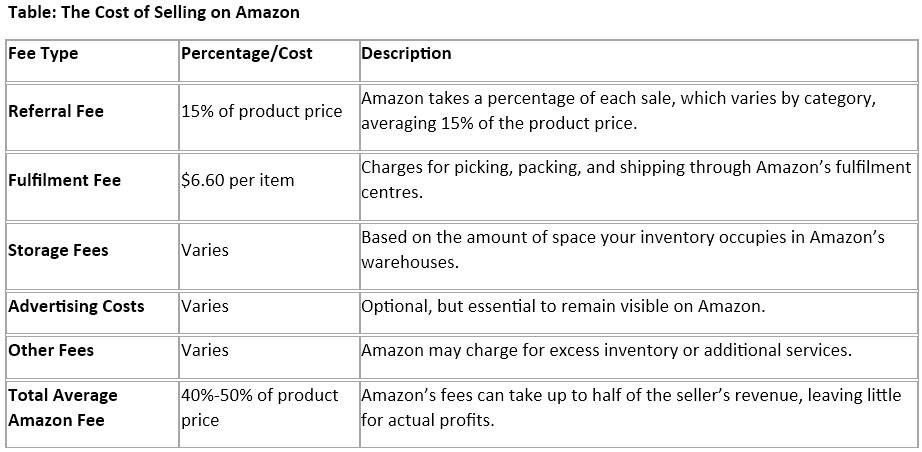How the E-Commerce Giant Bullies Sellers, Controls Prices, and Favours Chinese Companies:
See Video https://youtu.be/CIFSQtDDCj8?
Exposing the Dark Side of Amazon:
Amazon has evolved from a small online bookstore to a global e-commerce behemoth, dominating retail markets and reshaping how the world shops. But behind the scenes, the company's business practices reveal a much darker side, especially for third-party sellers who depend on the platform. In this detailed exploration, we’ll not only incorporate findings from TCN’s investigation but also integrate insights from other critical analyses to uncover how Amazon bullies’ sellers, manipulates prices, and favours Chinese companies at the expense of Western businesses.
The Illusion of Choice: Amazon’s Control Over Pricing:
Amazon gives customers the illusion of choice, offering an endless variety of products across its platform. However, many consumers are unaware that Amazon wields near-complete control over the prices sellers set. TCN’s expose uncovers how Amazon punishes sellers who list their products for lower prices on competing platforms such as eBay, Walmart, or their own websites. Sellers who violate this unwritten rule lose the Buy Box, the critical button that enables consumers to easily add a product to their shopping cart.
The Buy Box is Essential to Driving Sales:
Without the Buy Box, 95% to 99% of sales disappear, leaving the seller with little chance of competing. Sellers are forced into a lose-lose situation: raise prices on other platforms to stay in Amazon’s good graces or watch their business slowly vanish. This practice essentially allows Amazon to control pricing across the entire internet, creating an artificial price floor.
Other investigations, including by The Guardian, further highlight how Amazon's algorithms track pricing on competing platforms to ensure no one undercuts the prices listed on Amazon. Sellers who offer better deals elsewhere are immediately penalized, solidifying Amazon’s anti-competitive hold over the marketplace. This manipulation not only inflates prices but also stifles competition, turning what should be a free market into a controlled monopoly.
A Financial Squeeze: The High Cost of Selling on Amazon:
Amazon attracts millions of third-party sellers with the promise of access to a massive global audience. However, once sellers start using the platform, they quickly realize that selling on Amazon comes with a steep price.
As detailed by Molson Hart, the CEO of an educational toy company, selling on Amazon can mean losing a significant portion of revenue to the platform’s high fees.
See Video https://youtu.be/CIFSQtDDCj8?.
For a product priced at $17, Hart’s company is left with just $7 after paying various Amazon fees. Here’s how those fees break down:
- Referral Fee: Amazon takes a 15% commission from each sale, in this case, $2.55.
- Fulfilment Fee: Sellers who use Amazon’s fulfilment services are charged $6.60 for picking, packing, and shipping the product.
- Storage Fees: Sellers must also pay for inventory storage in Amazon’s warehouses.
- Advertising Costs: In order to stay visible and competitive, many sellers are forced to invest in Amazon’s advertising platform, further diminishing profits.
Hart’s experience is far from unique. Other sellers, such as those profiled in CNBC’s investigation, have shared similar stories, revealing that Amazon's fees can consume 40%-50% of a product's price, leaving sellers with razor-thin margins. Sellers must then raise prices across the board just to stay afloat, passing the costs directly to consumers. This hidden dynamic is part of Amazon’s pricing control strategy—making it look like prices are low, when in reality, Amazon’s fees inflate the true cost of products.

The Chinese Advantage: How Foreign Sellers Exploit Loopholes:
One of the most concerning aspects of Amazon’s business model is how it allows Chinese sellers to dominate the marketplace. As revealed by TCN’s investigation and supported by additional reporting from The Wall Street Journal, Chinese sellers have several distinct advantages over their American and European counterparts. These advantages allow them to outcompete Western sellers and drive down prices in a way that Western businesses simply cannot.
- Tax Evasion: Unlike American sellers, Chinese vendors are often able to avoid filing U.S. income taxes or complying with the same tax regulations. This saves them significant overhead costs, allowing them to sell products at lower prices.
- Lax Environmental and Labor Standards: Chinese factories are not subject to the same rigorous labour laws or environmental regulations that businesses in the U.S. or Europe must adhere to. This results in lower production costs, as Chinese manufacturers can operate in less regulated environments with cheaper labour.
- Proximity to Manufacturing: Chinese sellers are often located near the factories that produce their goods. This allows them to quickly iterate on product design and significantly lower costs associated with production and shipping, putting them at a significant advantage over Western sellers who must import goods.
- Government Subsidies: Many Chinese businesses also receive government support, including subsidies that further reduce the costs of producing and shipping goods. These government-backed initiatives enable Chinese sellers to flood Amazon with low-cost products, driving out Western competition.
Amazon has been criticized for favouring these Chinese sellers, despite widespread reports of counterfeit goods and quality issues originating from China. Investigations by Wired and other outlets have revealed how Chinese manufacturers can sell directly to consumers on Amazon, bypassing traditional distributors and middlemen. This practice, combined with lower regulatory costs, means that Western sellers are continually out competed, leading to the erosion of small businesses in the U.S. and Europe.
The Global Monopoly: Amazon’s Stranglehold on E-Commerce:
As Amazon’s grip on the e-commerce market tightens, its monopoly-like behavior becomes more evident. In addition to controlling pricing, Amazon’s algorithms scan the web for lower prices on competing platforms. If a seller offers their product at a lower price on Walmart or their own website, Amazon quickly removes the seller’s Buy Box, crippling their ability to make sales.
This practice of using the Buy Box as a tool for market manipulation has come under increased scrutiny. In a report by The New York Times, sellers expressed frustration at the unfair advantage Amazon has in dictating prices across multiple platforms. In some cases, sellers raised prices on other platforms just to avoid being punished on Amazon. The end result? Consumers end up paying higher prices across the entire internet, and the idea of fair competition is all but extinguished.
Amazon’s 50% market share in the U.S. online retail market gives it the power to control not just its own platform, but much of the broader e-commerce landscape. With its ability to dictate pricing and fees, Amazon acts less like a marketplace and more like a market gatekeeper—deciding who succeeds and who fails.
The Hidden Costs of Amazon’s Dominance:
While Amazon's low prices and convenience seem like a win for consumers, the reality is that the company's dominance stifles competition and ultimately drives prices higher. The costs that sellers face on Amazon inevitably lead to price inflation across the board, meaning that even those not shopping on Amazon are paying more. Monopolistic practices, coupled with the platform’s favouritism toward Chinese sellers, create an uneven playing field where small businesses struggle to survive.
As reported by ProPublica, many small sellers are now reliant on Amazon, unable to diversify their sales channels because Amazon has become so integral to their businesses. This reliance gives Amazon even more leverage over pricing, fees, and business practices, further entrenching its control over the market.
Conclusion: The Real Cost of Convenience:
TCN’s investigation, along with findings from other media outlets, paints a clear picture of Amazon’s dark side. What appears to be a convenient, low-cost platform for consumers is actually a monopoly that manipulates prices, stifles competition, and gives an unfair advantage to foreign sellers who are not subject to the same rules and regulations as Western companies.
As Amazon continues to grow, so too does its power over the global e-commerce landscape. Without meaningful reform or oversight, Amazon’s business practices will continue to crush small businesses, inflate prices for consumers, and further entrench a monopolistic grip on the retail market. Alternatives like Public Square offer a small glimmer of hope for independent sellers, but the question remains: How long can small businesses survive in Amazon’s shadow?
Until significant changes are made to how Amazon operates, consumers and sellers alike will continue to bear the hidden costs of the platform’s dominance.


